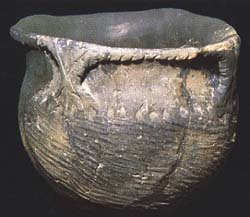
 |
Illinois pottery vessel from the Zimmerman site, a Kaskaskia Illinois village (1673-1722) |
They commonly use an earthen pot. (Pierre Delliette, 1702)![]()
The Illinois traditionally made containers of fired clay, bison hair, and plant fibers. Women gathered clay from natural deposits along streams, mixed it with crushed mussel shell, and then molded it (using the paddle-and-anvil technique) to create pottery vessels. These pots were jar-shaped vessels with rounded bodies, constricted necks, outflaring rims, and, in some cases, two or more handles that extended from the shoulder to the rim. The handles, rims, and shoulders of the pots were decorated with incised lines, notches, small indentations (punctates), and raised strips of clay that were applied to the rim below the lip. Beneath the shoulders of pottery vessels, the bodies were roughened by impressing them with grooved or cord-wrapped wooden paddles. After they had been fired in earth-covered hearths, the pots became durable, impermeable containers that could be used to carry water or cook food.
Illinois women spun bison hair to make yarn, which was then woven into cloth. Bison-hair cloth was used to create a variety of items, including leggings, scarves, garters, and sacks for storing animal pelts. Basket-weaving was not documented historically among the Illinois. However, the Illinois did use small reed mats to make medicine bags that war chiefs carried into battle.![]()
|
|
Copyright © 2000 Illinois State Museum